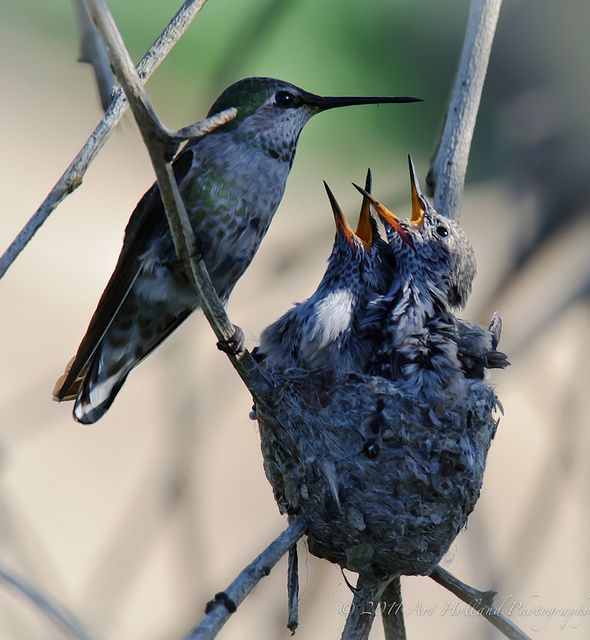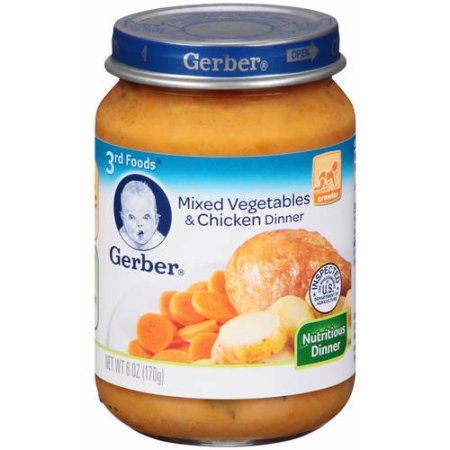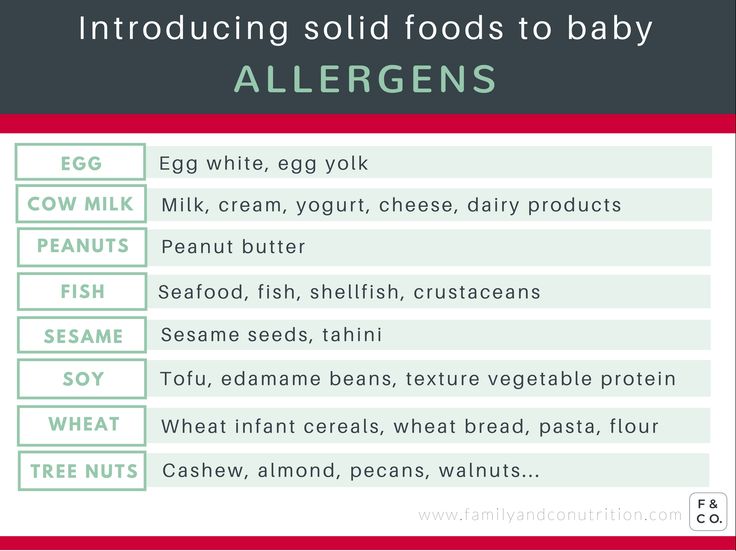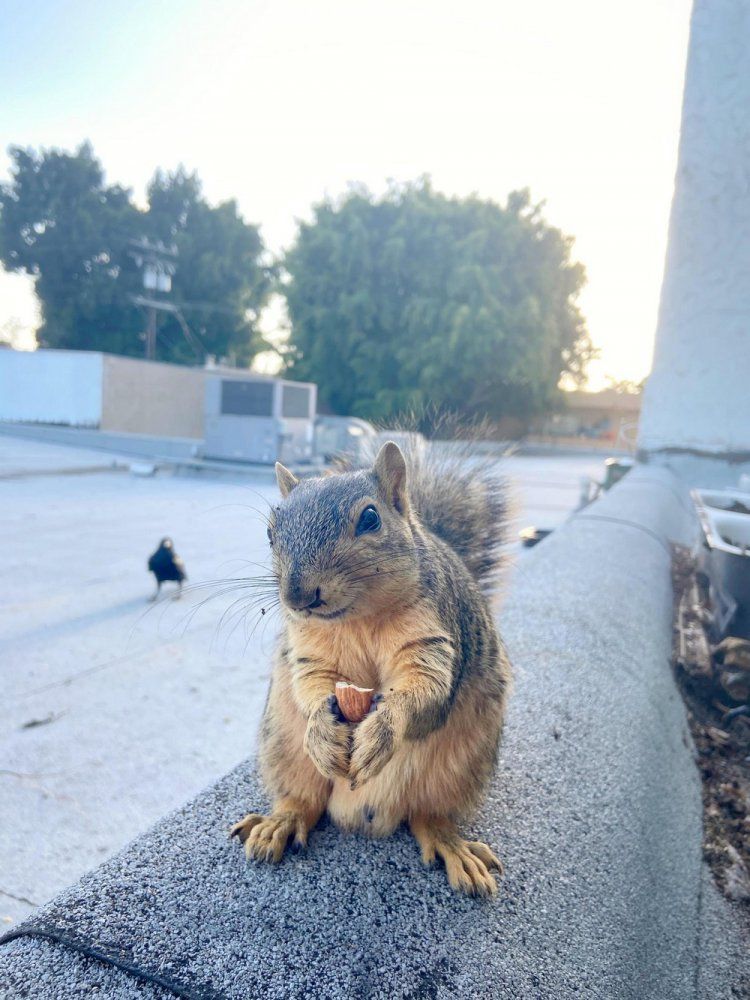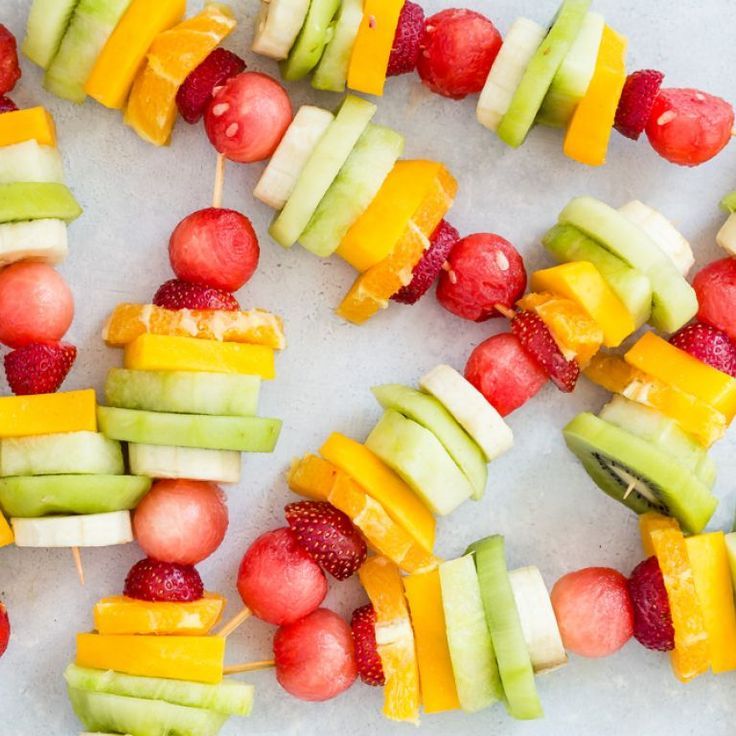Baby hummingbird at feeder
How to Feed and Care a Baby Hummingbird
Hummingbird chicks are tiny – so tiny in fact that if one is found in trouble, there is only a short window of time to get it the care it needs. If you do stumble across any struggling baby hummingbirds, you will need to act fast to ensure its survival. Knowing how to feed a baby hummingbird and what a baby hummingbird eats could make all the difference to this tiny creature.
However, it is worth noting that due to their itty-bitty size and delicate constitution we can often do more harm than good, especially if we don’t know what we’re doing. Therefore, the best thing you can do to help a hummingbird chick in need is to seek out the services of an experienced and licensed wildlife rehabilitator or veterinarian. According to Hummingbird Market, there is only a small window in which to initiate care to these tiny creatures;
“Your time-frame with hummingbirds is less than four (4) hours to initiate care and only about twenty-four (24) hours to get help before it may be too late. ”
So, it’s essential to act quickly.
In this Guide:
How do I know if it’s a baby hummingbird and not an adult?
Hummingbird chicks are significantly smaller than adults. When they first hatch, they are roughly an inch long. They also aren’t decked out in the same dazzling colors as their parents. Baby hummingbird hatchlings are black with no feathers.
This will change though. Hummingbird chicks grow rapidly, and they will soon develop a fuzz downing before feathers begin to grow and they develop that long beak.
How do you know if a hummingbird chick needs rescuing?
It can be tricky to tell whether a hummingbird needs rescuing or not – the mum is incredibly attentive, regularly but quickly feeding her chicks (taking roughly only 5 seconds) so it can be easy to miss the comings and goings of momma bird. However, if you’ve been watching the nest for between one and two hours and there’s been no activity then help may be required. Baby hummingbirds need to be fed frequently, without a regular source of food they will die so now is the time to call an expert for advice.
One sure-fire way to know if a hummingbird chick needs rescuing is if you find it on the ground.
What to do if you find a baby hummingbird on the ground?
Firstly, you’ll need to check for a nearby nest – it’s possible the hummingbird chick has fallen, or the nest is broken, damaged, or even have predators present. If the nest is safe gently pick the hummingbird chick up and place it back, then monitor to see if the mum comes to feed the chick. If she doesn’t then you will need to intervene.
It’s worth noting that hummingbirds have no sense of smell so that old-wives tale about hummingbirds abandoning their young if touched by a human is entirely incorrect. Just be gentle when picking up a hummingbird chick.
If there’s no nest or the nest is unsafe, then you can craft a make-shift one from a container lined with tissue (not fabric, this tangles around tiny feet and wings) and place it next to the nest, again waiting and watching to see if mum returns.
Really tiny hummingbirds can’t regulate their own body temperature and will need to be kept warm so you might have no choice but to bring it in, place it in a tissue lined container, and place it under a lamp to keep it warm. But watch out for signs of overheating: restlessness and panting.
But watch out for signs of overheating: restlessness and panting.
If you have had to intervene then be sure to call an expert for help, and whilst you wait for them you’re going to need to know what baby hummingbirds eat and how to feed a baby hummingbird to keep them alive.
What do baby hummingbirds eat?
Hummingbird chicks are fast-growing individuals and they can’t rely on nectar alone. They need a steady source of protein to assist their development, so in the wild, the mum will feed them a mix of soft-bodied bugs and sugary nectar. Bug and insects such as caterpillars, gnats, spiders, and aphids are likely to be on the menu.
When rescuing a baby hummingbird, you probably won’t have any regurgitated bugs to hand but a mixture of one part sugar to four parts clean water will suffice. Although this should not be fed for long periods as the hummingbird chick will die due to lack of protein – it is just until help arrives. This nectar solution shouldn’t be fed for more than 72 hours.
How to feed a baby hummingbird?
Now that you know what a baby hummingbird eats, you will need to know how to feed a baby hummingbird.
In the wild, the mum will regurgitate this sweet bug mixture into the hummingbird chicks throat, and she will do this up to three times an hour.
At home, a small eyedropper is a suitable substitute for a hummingbird’s beak. Fill a clean eye dropper with the liquid and present it in front of the hummingbird chick’s beak. Do not squeeze the dropper – this would release too much solution and causing the chick to drown. If the chicks are readily opening their beak then carefully drop 3 (younger) – 5 (fledglings) drops of the solution into their mouths.
Hatchlings can barely hold their head up and should be left to qualified and experienced wildlife rehabilitators and veterinarians to feed.
Baby hummingbirds are hungry so you’re going to need to replicate the mother’s behavior and feed them every 20 – 30 minute and through the night if they begin to call for food.
Hummingbird chicks are notoriously tricky to rehabilitate and whilst the bulk of the work will be carried out by a wildlife rescuer or veterinarian, by using your knowledge of what a baby hummingbird eats and how to feed a baby hummingbird, you are significantly helping its survival rate.
How to Help Hummingbirds | WildCare
The smallest of all birds, adult hummingbirds weigh only 0.1 to 0.3 ounces (2.5 - 8 gm).
Hummingbird nests and the babies they contain are vulnerable because they are so small. Even the most conscientious arborist or home gardener can easily overlook the miniscule and carefully-camouflaged nest of a hummingbird, with disastrous consequences.
The baby hummingbird in the video above has a horrific story-- he was found on the bumper of a tree trimmer's truck as it pulled into the greenwaste dump!
The arborists were convinced that they had checked the trees thoroughly from their last two jobs, so they were shocked to find the baby hummingbird on the bumper when they arrived at the dump.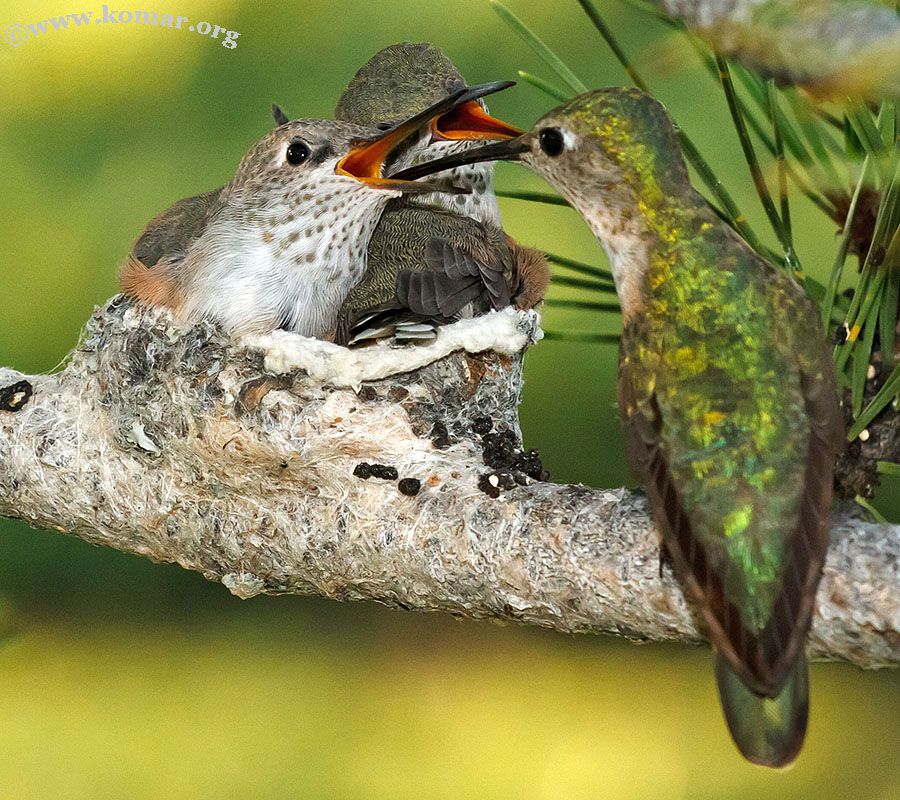 That he survived the tree trimming, the branch loading and the ride to the dump, and especially that he was spotted sitting on the bumper is nothing short of a miracle!
That he survived the tree trimming, the branch loading and the ride to the dump, and especially that he was spotted sitting on the bumper is nothing short of a miracle!
Unfortunately because the truck load was comprised of trees from multiple job sites, attempting to reunite the baby with his mom would be impossible. The arborist was very grateful to be able to bring the baby to WildCare!
This tiny orphan arrived at WildCare traumatized, dehydrated and chilled. Fortunately an exam determined that this tiny bird has no injuries and is in remarkably good shape, despite his ordeal. After being warmed up and receiving subcutaneous fluids (a challenging thing to do on a bird this small!) he started gaping for the specialized formula we give our hummingbird patients.
This hummingbird will go into care with a foster care specialist where he has an excellent chance of growing up healthy and ready to return to the wild.
How to help hummingbirds
Hummingbirds are admitted to WildCare's Wildlife Hospital for many reasons. A fluffy baby bird of any species found on the ground needs immediate help. If you find a baby hummingbird on the ground, gently pick her up, including whatever she's gripping with her feet. Hummingbirds have strong toes, and removing something from a baby's grip can actually break her tiny bones.
A fluffy baby bird of any species found on the ground needs immediate help. If you find a baby hummingbird on the ground, gently pick her up, including whatever she's gripping with her feet. Hummingbirds have strong toes, and removing something from a baby's grip can actually break her tiny bones.
Keep the baby warm, dark and quiet, don't try to feed her and don't peek at her. Call WildCare immediately at 415-456-7283.
It is absolutely not true that a mother bird will reject her young if a human has touched the baby, so please don't hesitate to pick up the baby bird! If you find an injured hummingbird of any age she is more likely to survive if you bring her to WildCare immediately.
Do not feed the bird. A cold, sick or injured bird may not be able to swallow the food and can aspirate (choke). Sugar water on a hummingbird's feathers can impact the bird's ability to thermoregulate (control body temperature), her water-proofing and even her ability to fly.
If you find an intact hummingbird nest in one of your trees, give it lots of space. Hummingbirds are very fast both in flight and in feeding their young. It is unlikely that you will even see the mother feeding her chicks and, if you get too close to the nest or are present for long periods, you may prevent the mother from feeding her babies.
If a hummingbird is caught inside, you can often lure the bird outside with a pot of brightly colored flowers. As with all birds, turning off lights, closing blinds and making the room as dark as possible to contrast with the open door will encourage the bird to fly out. Even better than potted flowers, if you have a hummingbird feeder, hanging it just outside the door will draw the bird out even faster.
Speaking of hummingbird feeders, please always keep your feeders clean! Especially in warm weather, the sugary food quickly grows bacteria that can be very bad for the birds. A feeder also attracts a larger-than-normal number of hummingbirds to a single area, which can spread disease.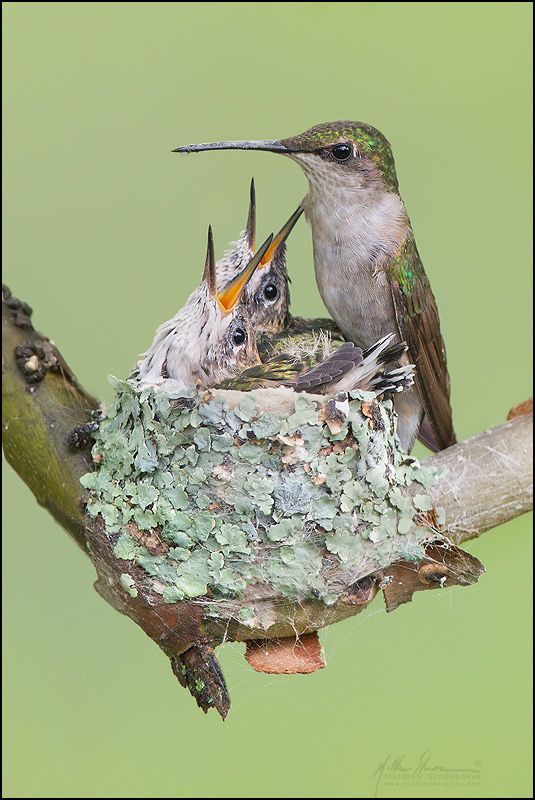 To properly clean hummingbird feeders, do NOT use bleach! Use vinegar and water in a 9:1 solution (9 parts water to 1 part vinegar) and special bottle brushes to get into small holes. Rinse thoroughly! Remember to change the food often-- fill with only enough to last 1-2 days (sooner if gets cloudy/moldy).
To properly clean hummingbird feeders, do NOT use bleach! Use vinegar and water in a 9:1 solution (9 parts water to 1 part vinegar) and special bottle brushes to get into small holes. Rinse thoroughly! Remember to change the food often-- fill with only enough to last 1-2 days (sooner if gets cloudy/moldy).
To further protect the hummingbirds in your yard, cats should be kept inside or in enclosures to protect both them and wild birds, including hummingbirds, which are particularly susceptible when feeding in flowers. This is especially important during the spring and summer months when young birds are fledging and learning to fly.
Caring for hummingbirds at WildCare
At WildCare sick, injured and orphaned hummingbirds are stabilized and kept in a warm, quiet environment.
Young hummingbirds need intensive, time consuming, and specialized care. The ingredients in hummingbird formula have to match their age-specific nutritional requirements precisely. As the chick grows, the percentage of insects and sugar in the formula is adjusted, as is the time between feeds. The enclosures in which they are kept need to be frequently modified too, in keeping with their age-related requirements.
As the chick grows, the percentage of insects and sugar in the formula is adjusted, as is the time between feeds. The enclosures in which they are kept need to be frequently modified too, in keeping with their age-related requirements.
Baby hummingbirds are fed every 20 - 30 minutes from dawn until dusk, and yes, our dedicated Hummingbird Foster Care person is a volunteer! Thanks to her, rescued baby hummingbirds like the ones in these photos grow up healthy and ready to return to the wild.
Being placed in the care of an expert is what saves the lives of most hummingbirds. Hummingbirds of all ages have tremendously fast metabolisms, so time is of the essence. Remember, if you find a hummingbird on the ground, please bring her to WildCare immediately. Call our Living with Wildlife Hotline 415-456-SAVE (7283) with any questions.
Click to donate now to help WildCare help hummingbirds this spring!
Hummingbird bird description
Native to America, hummingbirds mostly form a family called Trochilidae, which is also their scientific name.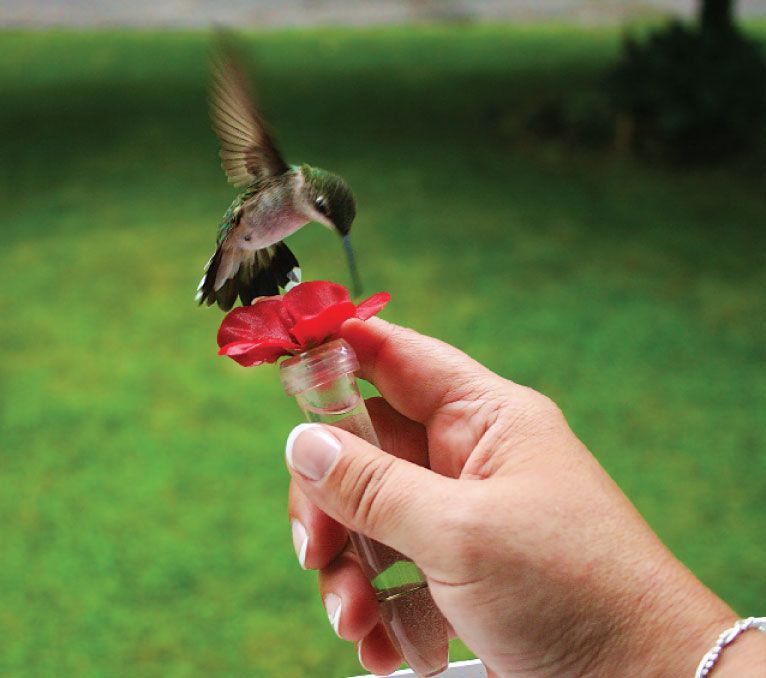 There are about 350 different known species of hummingbird. However, the list continues to be updated every year as changes are discovered.
There are about 350 different known species of hummingbird. However, the list continues to be updated every year as changes are discovered.
The smallest of the hummingbirds, the hummingbird bee, weighs only about 2 grams. By now, two species of these birds are known to have become extinct. They are also known for their ability to fly backwards.
5 Facts about Hummingbird
- Their average clutch size does not exceed three eggs, but the female will have one or two broods. The eggs are only half an inch long and the mother needs to take care of the eggs for about two weeks before they hatch.
The - Hummingbird is the only bird that can fly backwards, thanks to a wingspan that typically exceeds their full length by at least one fourth of an inch.
- They get their name from the buzz their wings make when they rapidly flap together.
- The hummingbird actually weighs only 2 grams at its adult size.
- These little birds have no sense of smell.

Hummingbird habitat
Hummingbirds can be seen in a variety of locations across America. However, even among 340 different species, these birds are not found outside the New World, so you may need to travel if you are in the Eastern Hemisphere.
Also read the article: Why are flocks of birds circling in the sky together
The easiest way to find one of these unique and special birds is to get close to the equator as these birds love the heat. With over half of the known species that live right along the equator, you can still spot them over Mexico.
Some of the places where these little birds are found include the Southwestern states such as California, Arizona, Texas and New Mexico. In these places, areas such as Texas' Davis Mountains State Park and Arizona's Ramsey Canyon Preserve are popular hummingbird sighting points.
Hummingbird: Size, Appearance and Behavior
These birds are small in size. Even the largest of these birds, the Giant Hummingbird of South America, is only about 8 inches long. However, different hummingbirds come in different sizes. The calliope hummingbird is three inches long while the hummingbird bee is 2.25 inches long. Meanwhile, topaz hummingbirds are 3.1 to 3.5 inches long.
Even the largest of these birds, the Giant Hummingbird of South America, is only about 8 inches long. However, different hummingbirds come in different sizes. The calliope hummingbird is three inches long while the hummingbird bee is 2.25 inches long. Meanwhile, topaz hummingbirds are 3.1 to 3.5 inches long.
These birds look a little different than regular birds, which is part of their beauty. Despite their streamlined squat bodies, they have gracefully long beaks and wings. While their extremely tiny legs can make walking difficult, they don't need to - their wings move about 10-15 times per second, allowing them to hover in place.
This incredible speed is just one way to make their flight extraordinary and exciting. The strength of their wings makes them the only birds that can fly backwards. In the blink of an eye, they can change direction, as if floating in the air. If they so desire, the bird is even capable of flying upside down .
These birds are known to be aggressive birds and often chase away intruders.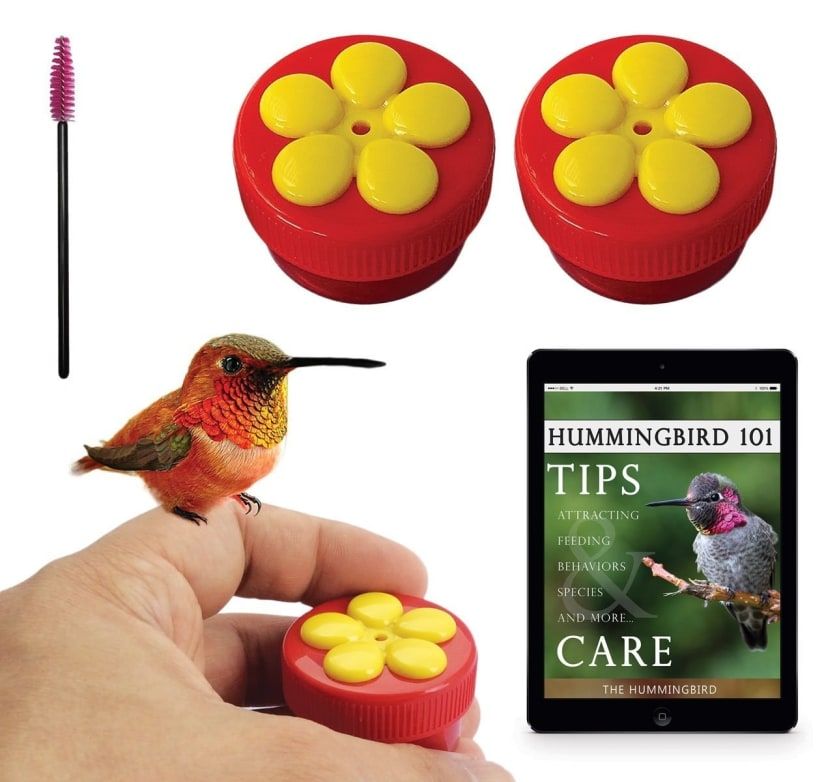 They are among the most ferocious birds, which often seems to belie their tiny size. Not only do they successfully drive away large birds, but they can also attack other animals and even people.
They are among the most ferocious birds, which often seems to belie their tiny size. Not only do they successfully drive away large birds, but they can also attack other animals and even people.
What do hummingbirds eat
Birds eat half their body weight of sugar, so sugar water is the easiest way to attract them to the bird feeder. These birds feed about five to eight times a day, also finding this sugar from nectar and fruits.
When not grazing on natural nectar, hummingbirds also look for insects and invertebrates as food. Their preferred food consists of ants, spiders, beetles, mosquitoes, midges, weevils, fruit flies and aphids, making them ideal guests in any home. In a pinch, they will also find any food captured in the web.
Hummingbird: Bird Predators and Threats
These birds, especially because of their tiny size, have many predators, which may be the reason why they have to be so aggressive to protect themselves. Their eggs are at constant risk of being predated, though one of their biggest threats is humans.
As cities become more urbanized, the natural habitat of these animals is shrinking. Deforestation is a major problem for hummingbirds, but the average bird lover can contribute by adding a hummingbird feeder and abundant foliage around their yard to attract birds to a place to build a nest and eat.
These birds are in constant danger as they avoid frogs, snakes, lizards, squirrels, chipmunks, blue jays, crows and other aggressive birds.
Their eggs also need special attention to avoid predators. Even after hatching, blue jays, squirrels, chipmunks and crows look for eggs and chicks.
Hummingbird reproduction, babies and lifespan
Hummingbirds start mating when they are one year old. Each year, female hummingbirds can raise up to three cubs - that is, six hummingbird cubs per year.
Before mating, the male hummingbird must convince the female hummingbird that he will be the perfect mate for her. For this reason, males tend to be slightly more colorful, which is a natural evolutionary trait of most bird species.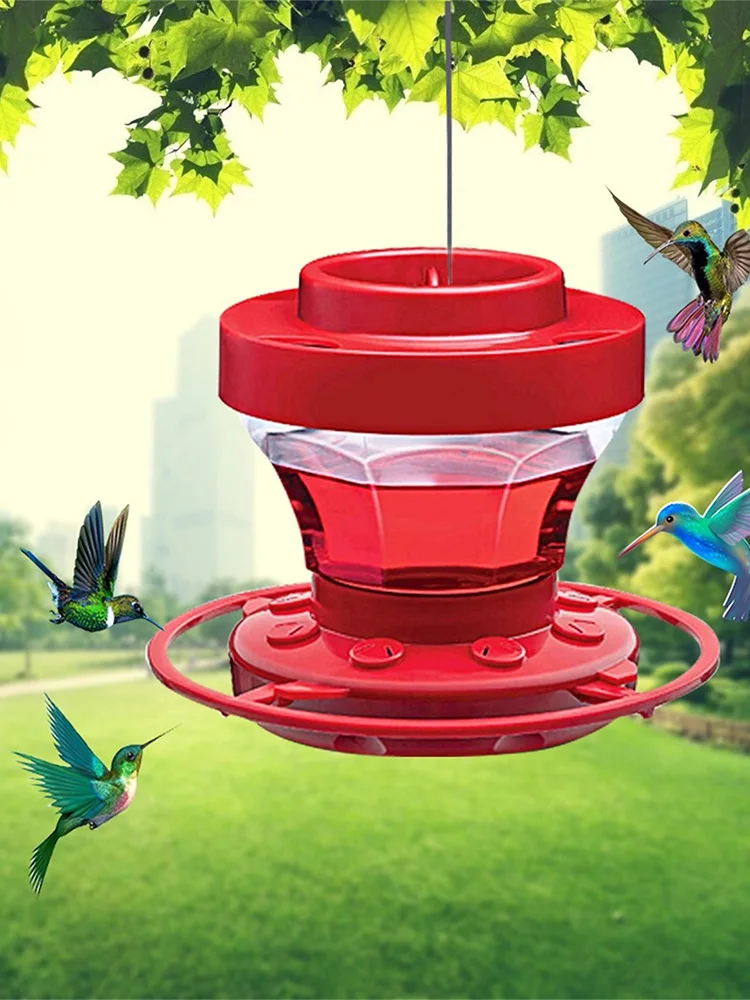
Female hummingbirds are known to be single mothers; after fertilization of the female, the males continue their lives. She stays to lay her eggs, incubating them for about two weeks. Eggs are the size of sea beans. As a general rule, female hummingbirds usually only lay two eggs in a single breeding session.
Their young, called chicks, remain in the nest while their mother feeds them for four weeks after birth. The life span of a hummingbird is three to five years.
Hummingbird population
While the exact population of hummingbirds is unknown, some hummingbird species, such as the ruby hummingbird, number up to 34,000,000 in an official US study. There are over 300 different species, although about half of the birds live along the equator
FAQ:
Do hummingbirds migrate?
During the summer months, these birds are found in parts of North America. However, most of these tiny birds migrate to other places.
However, most of these tiny birds migrate to other places.
How many eggs does a hummingbird lay?
Female hummingbirds lay two eggs at a time.
How fast does a hummingbird fly?
Some hummingbirds fly at about 90 km per hour.
What is the wingspan of a hummingbird?
The average wingspan of most hummingbirds ranges from three to five inches.
When do hummingbird chicks leave the nest?
Hummingbirds leave their nest about 18-28 days after birth.
How many species of hummingbirds are there ?
Hummingbirds have about 350 different known species.
What habitat do hummingbirds live in?
Hummingbirds live in tropical forests and tropical jungles.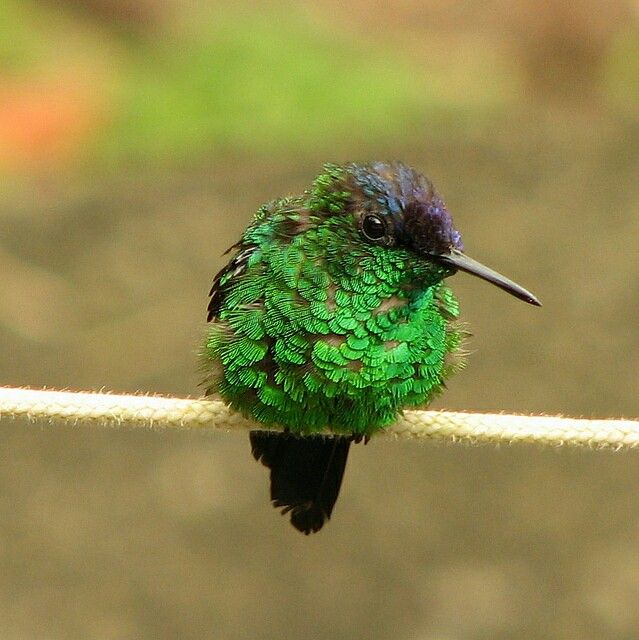
What is the main prey for a hummingbird?
Hummingbirds feed on nectar, tree sap, insects and spiders.
What are the predators of hummingbirds?
Hummingbird predators include hawks, snakes and lizards.
What is the lifespan of a hummingbird?
Hummingbirds can live from 3 to 5 years.
Wild hummingbirds have shown ability to count
July 09, 2020 14:48 Anatoly Glyantsev
Hummingbirds have shown unexpected aptitude for mathematics.
Pictures
(a) installed feeders; (b) a bird checking the contents of the feeder; (c) layout options for rows of feeders; (d) distances between adjacent feeders in two phases of the experiment.
Illustrated by Tom Oldridge/Tas I. F. Vamos et al./Proceedings of the Royal Society B (2020).
Scientists for the first time have identified the ability to perceive the order of numbers in wild vertebrates. Biologists conducted an experiment that showed that hummingbirds remember which feeder contains the delicacy.
Scientists have for the first time discovered the ability to perceive the order of numbers in wild vertebrates. Biologists conducted an experiment that showed that hummingbirds remember which feeder contains the delicacy.
Achievement described in a scientific article published in Proceedings of the Royal Society B.
Scientists have already done many experiments showing that animals have many abilities that were once considered a privilege of man. Among them is the understanding of the difference between the first, second and so on object in a row.
However, until now, such experiments (at least on vertebrates) have been carried out on animals living in laboratory conditions. Do their wild relatives have the ability to count? This is the question that biologists from the UK and Canada have asked themselves.
Experts studied the behavior of buffy hummingbirds ( Selasphorus rufus ) living in the Rocky Mountains of North America. The test subjects were nine males of this species.
Note that each "severe man" among these birds occupies a certain territory, to which he does not allow competitors. In addition, all nine individuals were briefly captured and marked with harmless paint so that scientists could distinguish them from relatives.
The experimenters placed ten feeders in each male's area. They were located one after another in a straight line at equal distances from each other. The shape and size of these structures somewhat resembled flowers (the nectar of which hummingbirds feed in the wild). Sugar syrup was poured into one of the feeders.
At first, the syrup was always in the first feeder. After the bird got used to this fact, the syrup was poured into the second "flower".
Not finding a treat in the usual place, the animal began to examine the neighboring feeders and found syrup. The researchers waited for the hummingbird to fly up to the second “flower” at least four times in a row, without dipping its beak into any other feeder (including the first one) before that. After that, they again changed the conditions of the experiment: now the treat was in the third feeder. Then the syrup was transferred to the fourth in the same way.
Let's note a number of important details. It took the bird time and a number of failed attempts to remember where to dine. Therefore, we can exclude the hypothesis that she simply found the syrup by smell.
Therefore, we can exclude the hypothesis that she simply found the syrup by smell.
In addition, the experimenters changed the orientation to the cardinal points of a line made up of feeders. So they made sure that the bird does not focus on a specific point in the area in which the coveted treat is located.
Finally, biologists have found out that the hummingbird remembers the right feeder not because of its appearance. To do this, they each time decided anew which of the available set of feeders would be the first, which - the second, and so on. Thus, in the "prize" place, promising sweet syrup, each time there was a new "flower".
(a) fixed feeders; (b) a bird checking the contents of the feeder; (c) layout options for rows of feeders; (d) distances between adjacent feeders in two phases of the experiment.
Illustrated by Tom Oldridge/Tas I. F. Vamos et al./Proceedings of the Royal Society B (2020).
But maybe the bird just remembers how far to fly from the beginning of the row? To test this, experts set up a decisive experiment.
When all nine males firmly learned that sweetness awaits them in the fourth "flower", the authors changed the distance between the feeders. Previously, every two adjacent feeders were located 20 centimeters apart. Now the distance between the "neighbors" was chosen randomly. It could be 10, 30 or 40 centimeters.
Thus, if the hummingbird had simply memorized how many centimeters to fly before the treat, this time it would miss the target. And how did the birds behave in reality?
Each of the nine males under the new conditions was given four attempts. Some all four times immediately flew up to the desired "flower", demonstrating that they remembered what it was in a row. There were also those who made a mistake all four times. But on average, a male hummingbird flew up to the correct feeder 1.78 times out of four. This is much more common than one would expect from random guessing.
The authors conclude that hummingbirds have indeed shown an understanding of numerical order.